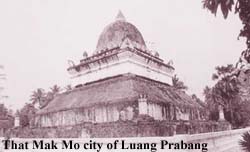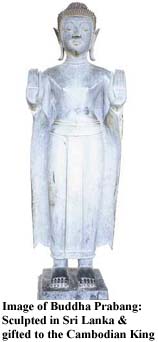 |
 8th November 1998 |
Front Page| |
When Lanka gifted Buddhism to Laos
Over 200 delegates will gather at the BMICH tomorrow for The International Buddhist Conference. The conference, which continues till November 14, is being held to mark Sri Lanka's 50th anniversary of Independence, and is organised by the Foreign Affairs and Buddha Sasana ministries. It has as its theme "The timeless message of the Buddha"and will have participation from Buddhist leaders from several countries, Cambodia, Thailand, Italy, Australia and Laos among them. In this article, Dr. Hema Goonatilake, Senior Advisor, of the Buddhist Institute, Cambodia traces the Buddhist links between Sri Lanka and Laos. The Lao People's Democratic Republic is still an idyllic country,perhaps the least contaminated in South East Asia. With a population of less than five million, Laos is land-locked between Thailand, Burma,China, Vietnam and Cambodia. Over half the population in Laos observe Theravada Buddhism, while the rest comprising more than 60 ethnic groups living on the hills adhere to the traditional beliefs of spirit cults. A Cambodian woman introduced Sri Lankan Buddhism to Laos.The recorded history of Laos with the formal introduction of Buddhism begins during the reign of Fa Ngum (1353- 1373), although Buddhism was known in the Lao region by the 8th century. Just before this time, a distinct shift from Mahayana to Theravada had occurred in Cambodia. During the reign of King Jayavarman Paramesvara (1327- ), Sri Lankan monks played a major role in the promotion of Theravada Buddhism in Cambodia. The King's daughter, Nang Keo-Keng-Ya who was raised in a strong Buddhist environment was given in marriage to Fa-Ngum. Fa-Ngum who was himself raised in the Cambodian royal palace, was an heir to Lao territories. With military assistance from the Cambodian King, Fa Ngum conquered the Lao territories, and in 1353, he founded the kingdom of Lan Xang (present-day Laos) which he named Lan Xang (literally a million elephants). When Queen Keo-Keng-Ya found that the people in the Lao kingdom killed elephants and buffaloes for sacrifice in the practice of spirit cults,she wanted to go back to Cambodia unless Buddhism was introduced to the Lao kingdom. The King Fa Ngum then, sent a mission to his father-in-law requesting a delegation of Buddhist monks. The leader of this Buddhist delegation was Maha Tep Langka of Sri Lanka. The other members of the delegation were the king's own tutor Maha Pasman, the younger brother of Maha Tep Langka , another Sri Lankan Mahathera by the name of Nandipanna, 20 other monks and three other experts, Norasing, Norasan Noraray and Noradet. The mission also planted a Bo tree according to the Sri Lankan tradition and later a wat by the name of Wat Po Lanka-the Lanka Bodhi vihara was constructed near the Bo tree. A Sri Lankan monk became the first Sangharaja of Laos. The introduction of Sri Lankan Buddhism not only served as a symbol of legitimisation of Fa-Ngum's authority, but also as an important factor for moral unity and consolidation of the Lao state. The monks on the Cambodian delegation who introduced Buddhism to Laos were accorded the highest royal honour, and resided in the royal monastery Wat Keo which was specially constructed for the purpose. Venerables Maha Tep Langka and Maha Pasman were appointed by the King to the ranks of Sangharaja of the kingdom. The Cambodian delegation to Laos brought with them the Tripitaka and a famous image of the Buddha known as Prabang, sculpted in Sri Lanka. A book, The Story of Prabang, written in the 16th century, and available only in the Lao language describes the historical significance of this image.
This image which is in the mudra of "Calming Quarrels" is said to have been cast in an alloy of gold, silver and other metals in 874 A.C. by Culanagha Thera (or Cunnaka Thera) in Sri Lanka. King Siricantarat (or Srichularaj) of Intapatta (present day Cambodia) sent an embassy to King Supinarat of Lanka Taveep (Sri Lanka) in 1056 A.C., requesting the image, and the Sri Lanka King sent it as a gift to the Cambodian king. It was King Vijayabahu I ((1055-1110 A.C.) who ruled in Sri Lanka during this time, but Sri Lankan sources do not make any reference to this event. The image of Prabang became the symbol for the sovereignty of the Lao kingdom. Its capital city was named Luang Prabang in honour of the image, and to this date remains as the cradle of Buddhism. Deep veneration was paid to this image over the centuries by several kings by constructing special wats - Wat Ho Prabang, Wats Monoram, Visoun and Mai - to house the image. This image which was later taken to the city of Vientiane, was seized by the Siamese and returned to its home in Luang Prabang in the 19th century, and was installed in the Royal Palace. It is now kept in the museum in Luang Prabang, and is the country's most protected national treasure. Laos was also proud of possessing two other Buddha images from Sri Lanka, though for a brief period. King Potisarath (1520-1550) of Laos who spent some time in Chieng Mai, Thailand brought the images of the Emerald Buddha and Phra Seekham -also known as Sinhala or Sihinga Buddha image - on his return to Laos. This Emerald Buddha image is the national palladium of Thailand today. A revival of Buddhism Over the centuries, Laos was fraught with internal strife, as well as invasions and threats of invasions by Burma, Siam and Vietnam, during which period Buddhism suffered a set back. In 1893, the French gained control and ruled Laos as a part of the Union of Indochina together with Vietnam (which included Tonkin, Annam and Cochinchina) and Cambodia. The French attempt to spread Catholicism in Laos did not succeed, partly because the anti-colonialist revolutionary movement had the active support of the Buddhist monks. Although in 1953, the French rule ended with the granting of full sovereignty, the country saw the end of civil unrest only in 1975 when the communist Pathet Lao, after a long struggle, took complete control. Under the communist rule, although there was no attempt to destroy Buddhism and its culture by killing Buddhist monks, demolishing wats and burning Buddhist texts as in Cambodia during the Pol Pot regime, Buddhism suffered a significant set back. The abolition of the monarchy which was the guardian of Buddhist heritage and the change of the national emblem from the silhouette of That Luang to the Soviet hammer and sickle and the Vietnamese star represented the ideological change. The earlier structure of the Sangha which was headed by a Sangharaja was replaced by a Chief of the Sangha (Padhan Song). The strict ascetic sect of Thammayut nikaya which was introduced in the early 1940s from Thailand was banned in 1975, and there is only one sect which is called Phra Song Lao (Lao Sangha)There were 20,000 monks and novices in 3441 monasteries in Laos before the Lao Revolution in 1975. The number has now returned almost to the pre-revolution levels with 17,990 monks and novices in 2823 monasteries. As in other Theravada countries in South East Asia, Buddhism continues to exist alongside animism with no conflict. The wat (temple) compound usually has a spirit (phi) house for the guardian of the village.Harmonious fusion of Buddhism with the worship of spirits is most striking in the Buddhist festivals. |
||
 |
More Plus *Eppawala: going into a deal not knowing much?
Front Page| News/Comment| Editorial/Opinion| Business| Sports | Mirror Magazine |
|
 |
Please send your comments and suggestions on this web site to |
|

